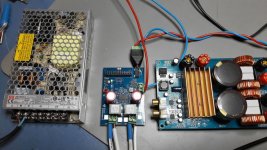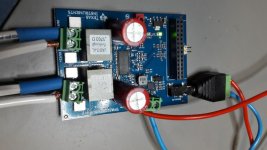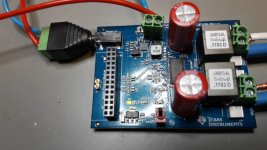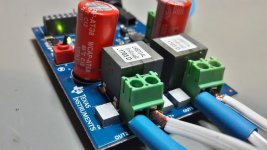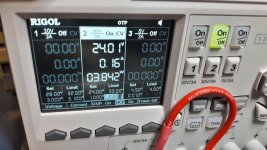Has anyone played with the TPA3220 Class D amplifier chip from Texas Instruments?
To me, it looks like it sits nicely between TI's top of the line chps, such as tpa3251 and tpa3255, and their previous-gen chips, such as tpa3116/tpa3118.
The tpa3220 is a power pad down chip, like the tpa3118. This means it's designed to use the PCB itself as a heatsink. As there is also a pad-up tpa3221 chip, I'm guessing it's similar to the tpa3118/3116: same silicon, different only in power-pad orientation. Again, that's just speculation on my part!
For me personally, I wanted to design a board with the 325x chips, but they are considerably more complex than the old 311x family. Definitely doable, but a bigger project than I want to take on. This 3220 is a bit more complex than the 311x, but not so much as the 325x. So should be easy to DIY some PCBs.
Another interesting point with the 3220, is TI has a standard evaluation module (EVM), but also a micro EVM. The evm-micro, as the name suggests, is much smaller: 60x80, and also much cheaper: $50 from TI direct, as well as from Mouser and DigiKey. (I tried the "highpoweraudio" discount code on TI's site, didn't work for me with this board.) While not as cheap as the stuff from China, you have a much better chance of getting legit parts and no "shortcuts" in implementation.
While reading over the evm-micro's user guide, I saw they are using these new inductors from Coilcraft: the UA801x series, which was developed with TI specifically for TPA3220, TPA3244 and TPA3245 output filters. The specs look good: nice flat inductance versus current curve, low DCR. Not quite the current capabilities or low DCR of the VER2923/SER2900, but substantially cheaper. They are also dual inductors, i.e. two inductors in one package.
I plan to buy the evm-micro and a Meanwell EPP-200-27 power supply for what looks like a decent plug-and-play amp with pretty good specs.
Here are some relevant links:
To me, it looks like it sits nicely between TI's top of the line chps, such as tpa3251 and tpa3255, and their previous-gen chips, such as tpa3116/tpa3118.
The tpa3220 is a power pad down chip, like the tpa3118. This means it's designed to use the PCB itself as a heatsink. As there is also a pad-up tpa3221 chip, I'm guessing it's similar to the tpa3118/3116: same silicon, different only in power-pad orientation. Again, that's just speculation on my part!
For me personally, I wanted to design a board with the 325x chips, but they are considerably more complex than the old 311x family. Definitely doable, but a bigger project than I want to take on. This 3220 is a bit more complex than the 311x, but not so much as the 325x. So should be easy to DIY some PCBs.
Another interesting point with the 3220, is TI has a standard evaluation module (EVM), but also a micro EVM. The evm-micro, as the name suggests, is much smaller: 60x80, and also much cheaper: $50 from TI direct, as well as from Mouser and DigiKey. (I tried the "highpoweraudio" discount code on TI's site, didn't work for me with this board.) While not as cheap as the stuff from China, you have a much better chance of getting legit parts and no "shortcuts" in implementation.
While reading over the evm-micro's user guide, I saw they are using these new inductors from Coilcraft: the UA801x series, which was developed with TI specifically for TPA3220, TPA3244 and TPA3245 output filters. The specs look good: nice flat inductance versus current curve, low DCR. Not quite the current capabilities or low DCR of the VER2923/SER2900, but substantially cheaper. They are also dual inductors, i.e. two inductors in one package.
I plan to buy the evm-micro and a Meanwell EPP-200-27 power supply for what looks like a decent plug-and-play amp with pretty good specs.
Here are some relevant links:
Hi Matt
very nice idea! 60x80mm is super smal,
question:
why using the Meanwell EPP-200-27 and not the LRS series?
TPA3220 +3221 are the HD version with less power.
then more power TPA324x --> TPA435x
the TPA3156D2 are also with smal evm boards but they are not Pure path HD.
correct?
BTW: TPA3220 micro evm order TI + shipping + takes 68$
very nice idea! 60x80mm is super smal,
question:
why using the Meanwell EPP-200-27 and not the LRS series?
TPA3220 +3221 are the HD version with less power.
then more power TPA324x --> TPA435x
the TPA3156D2 are also with smal evm boards but they are not Pure path HD.
correct?
BTW: TPA3220 micro evm order TI + shipping + takes 68$
Last edited:
Thanks for the heads up Matt - I went straight to the part where they talk about the power supplies for the signal processing stages and was encouraged to find the following :
To reduce device power losses an external 5 V supply can be used for the AVDD and VDD supply pins. The internal voltage regulator connected to the VDD pin is automatically turned off if an external 5 V supply is used for this pin. Although supplied from the same 5 V source, separating AVDD and VDD on the printed-circuit board (PCB) by RC filters (see application diagram for details) is recommended. These RC filters provide the recommended high-frequency isolation.
The weakness of the TPA3251 I found was in the internal regulator for the opamp stages. TPA3116 doesn't expose the power pin for those but this chip does, so this sounds rather promising - despite the lack-lustre IMD plots.
To reduce device power losses an external 5 V supply can be used for the AVDD and VDD supply pins. The internal voltage regulator connected to the VDD pin is automatically turned off if an external 5 V supply is used for this pin. Although supplied from the same 5 V source, separating AVDD and VDD on the printed-circuit board (PCB) by RC filters (see application diagram for details) is recommended. These RC filters provide the recommended high-frequency isolation.
The weakness of the TPA3251 I found was in the internal regulator for the opamp stages. TPA3116 doesn't expose the power pin for those but this chip does, so this sounds rather promising - despite the lack-lustre IMD plots.
The TPA322X series is not part of the "High Power Audio" Akita family (TPA324X, TPA325X) even if they share a similar pinout and package. It is more like a TPA3116/56 on stereoids. They inherited some of the Akita features like to bring THD down a bit and security features (CB3C current limit). Other features were cut/skipped to keep the "costs" down.
looks interesting. The linked micro EVM guide is not available actually, would be interested to have a look at it.
The link works for me, it's direct to TI's site. Is it not working for you? But yeah, not pin-compatible at all with tpa311x.
question:
why using the Meanwell EPP-200-27 and not the LRS series?
Main reason is the EPP series is physically much smaller. I like to use the "2205" aluminum case that is readily available on ebay for $50ish or less. But if space wasn't a concern, LRS series is generally cheaper. Also, there is no 27-volt option in the LRS series.
BTW: TPA3220 micro evm order TI + shipping + takes 68$
Yeah, in the USA if you order from Mouser or DigiKey, you can get a cheaper shipping option.
The weakness of the TPA3251 I found was in the internal regulator for the opamp stages. TPA3116 doesn't expose the power pin for those but this chip does, so this sounds rather promising - despite the lack-lustre IMD plots.
Indeed, I like the "best-of-both-worlds" flexibility: use your own 5v supply(ies) for VDD, AVDD, GVDD; or use the built-in LDO for simplicity.
The TPA322X series is not part of the "High Power Audio" Akita family (TPA324X, TPA325X) even if they share a similar pinout and package. It is more like a TPA3116/56 on stereoids. They inherited some of the Akita features like to bring THD down a bit and security features (CB3C current limit). Other features were cut/skipped to keep the "costs" down.
thanks doc!

becuase the 3 e tpa3250 is not available....
In case you haven't seen it: looks like 3e-Audio is trying to do another run/group buy of tpa32xx amps.
The weakness of the TPA3251 I found was in the internal regulator for the opamp stages.
The THD performance of the TPA325X is better than the TPA322X so whats the exact issue? Have you compared 325X vs. 322X already?
In case you haven't seen it: looks like 3e-Audio is trying to do another run/group buy of tpa32xx amps.
thank you Matt...i read it...but i want to try some very small one....as doctor wrote and visible in the datasheet.....the thd are not as good as the tpa325x......but ...
regards
chris
The THD performance of the TPA325X is better than the TPA322X so whats the exact issue?
We've had this conversation already - no point in going over it again. The TL;DR version is that performance for you means measurements, for me its how it performs subjectively on music.
Have you compared 325X vs. 322X already?
Not yet but I have one of the modules Matt's just introduced on this thread on order. It's going to be a few weeks for it to arrive.
.the thd are not as good as the tpa325x......but ...
The THD numbers don't give much away about how a chip's going to sound on music. One example being TDA8932 - on measurements on the stock implementation its way poorer than a stock version of TPA3255. Yet my modified TDA8932 is my reference SQ amp, the TPA3255 I have still needs plenty more work on the PSU and input stages to get it up to the TDA8932 level.
The THD numbers don't give much away about how a chip's going to sound on music. One example being TDA8932 - on measurements on the stock implementation its way poorer than a stock version of TPA3255. Yet my modified TDA8932 is my reference SQ amp, the TPA3255 I have still needs plenty more work on the PSU and input stages to get it up to the TDA8932 level.
yes i agree the amps or boards are different implementation of the power chips...commercial chinese use the values of th power chip to sell more....
this has nothing to do with SQ. some of my YJtpa3255 boards are sounding partly better as the original 3251evm
i remember this AVDD topic...
too much amps at home
Check p19 of the TPA3220 datasheet. There's a table of resistor values vs gains.
Ahh.. sorry i over scrolled it....i am in the office...
Hi
Thanks to TI and Fedex the board arrived today. i connected and powered it up and its works...
i use my DP832 rigol with 24V set.
if i power it no current was shown on the psu display.. reset switch off and 160mA run at 100mVrms through the amp into 8R i get 9,8Vpp ---> so Gain is 30dB...as written in Datasheet.
reset switch off and 160mA run at 100mVrms through the amp into 8R i get 9,8Vpp ---> so Gain is 30dB...as written in Datasheet.
i bought for listening this 7 euro cable:
Cinch auf Klinke Kabel 2M,Victeck 3.5mm Klinke auf 2 Cinch Y Splitter Stereo Audio Kabel, Nylon Geflochten Klinkenkabel,Vergoldet Metall Stecker: Amazon.de: Elektronik
since 3 hours this amp is running at 24 into 8R with sweep of 100mVrms 10Hz-35kHz. room is 24°C this amps stay at 34°..
power:
about 10Vpp into 8R i got about 1,5Watt per channel...fine
its really very tiny...to connect my fat test cables...
to fix this amp board in a housing or fix for test...no idea..
chris
Thanks to TI and Fedex the board arrived today. i connected and powered it up and its works...
i use my DP832 rigol with 24V set.
if i power it no current was shown on the psu display..
i bought for listening this 7 euro cable:
Cinch auf Klinke Kabel 2M,Victeck 3.5mm Klinke auf 2 Cinch Y Splitter Stereo Audio Kabel, Nylon Geflochten Klinkenkabel,Vergoldet Metall Stecker: Amazon.de: Elektronik
since 3 hours this amp is running at 24 into 8R with sweep of 100mVrms 10Hz-35kHz. room is 24°C this amps stay at 34°..
power:
about 10Vpp into 8R i got about 1,5Watt per channel...fine
its really very tiny...to connect my fat test cables...
to fix this amp board in a housing or fix for test...no idea..
chris
Attachments
I just fired up my board which arrived a couple of days ago. Initial impressions - too shouty on orchestral violins and massed vocals. Turns out there's a very simple fix for this though - increasing the value of C19 (which is a 100nF, decoupling the analog signal rail). I have 1800uF/6.3V in parallel there now, no idea how much overkill it is but it sweetens up the top end magnificently 
- Status
- This old topic is closed. If you want to reopen this topic, contact a moderator using the "Report Post" button.
- Home
- Amplifiers
- Class D
- tpa3220: diy, evm-micro, UA801x-AL inductors, etc
